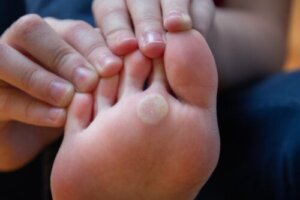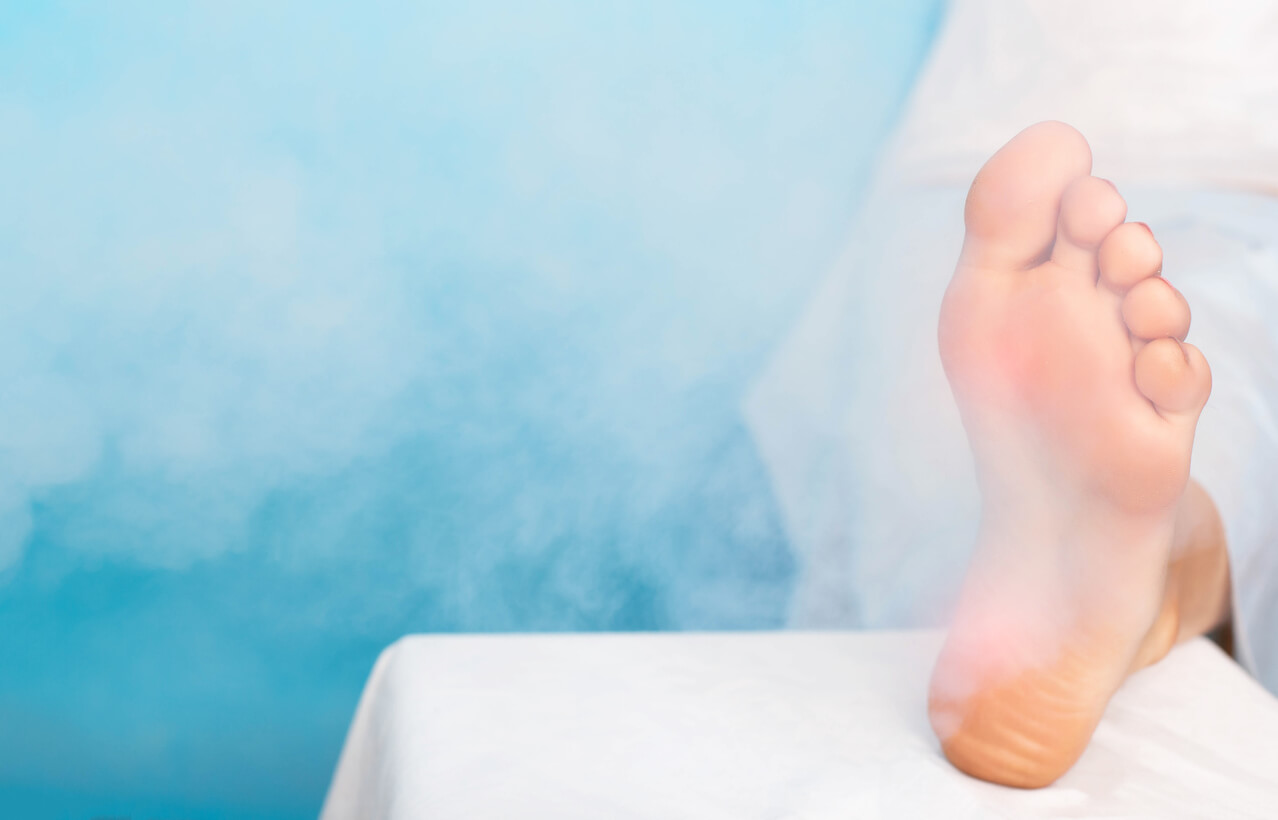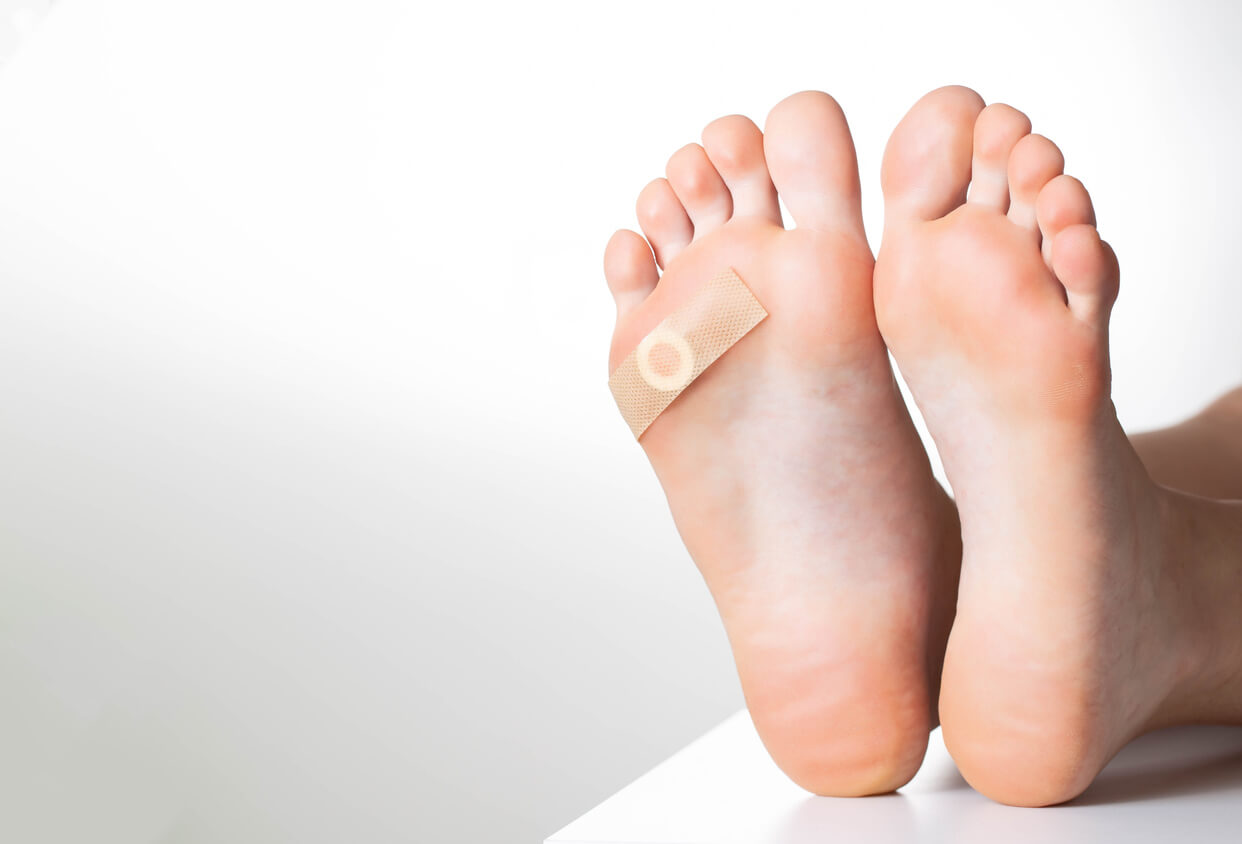Plantar Warts in Children: What Are They and How to Treat Them?


Written and verified by the dermatologist Maria del Carmen Hernandez
What are plantar warts?
Warts are skin growths that are benign and can occur on different parts of the body and in different forms. In addition, they’re developed by a virus of the HPV family, are contagious, and are very common. Moreover, although they can affect people of any age, they’re more common among adolescents and children. The most common variants are the following:
- Common
- Plantar
- Flat
- Genital
Most common causes of plantar warts
Warts are caused by the human papillomavirus (HPV), of which there are more than 100 different types. This variety of viral agents enters the skin surface through small wounds and causes additional cell growth. The outermost layer of the skin becomes harder and thicker and generates a raised wart. In most cases, the viruses are transmitted by direct skin contact.
Transmission can even occur by touching certain objects, such as towels. Some people have an increased risk of developing warts. Namely:
- Children with atopic diseases, such as eczema
- People with weakened immune systems
- Teenagers or children who use communal showers
Read also: The Relationship Between Food and Eczema in Babies
The most common treatments

In most cases, warts are harmless to children with a healthy immune system. They often disappear on their own, depending on the state of health, the type of virus, and the wart.
Salicylic acid topication
This type of procedure can cause irritation of the skin surface, although it’s usually well tolerated. The solution is applied several times a day to the hardened skin for a few weeks. The advantages of salicylic acid include convenience, minimal cost, reasonable effectiveness, and negligible pain. The disadvantages are that results require weeks to months of treatment.
Cryotherapy
This procedure uses liquid nitrogen to destroy the wart by freezing. It’s actually performed by a dermatologist and requires more than one session. Because the nitrogen is very cold, it can cause stabbing pain and redden the skin.
Surgical excision by cauterization or curettage
Surgical excision and cauterization of warts aren’t recommended as a standard treatment because they can be painful and cause scarring. In addition, as with any destructive treatment, there’s no guarantee that the wart won’t recur. In fact, recurrence rates can be as high as 30%.
You may be interested in: Molluscum Contagiosum in Children: What You Should Know

Foot care for children
Ideally, children’s feet should be cared for to prevent various skin conditions or manifestations:
- Opt for footwear with the correct size and quality materials.
- Explain to the child that shoes shouldn’t be exchanged with friends or siblings, as there are several skin diseases that are contagious.
- The constant and correct hygiene of the feet is essential to prevent and avoid fungus or infections.
- After each bath, towel drying should be meticulous, and you should make sure that there’s no persistent moisture between the toes, as this area is prone to develop interdigital mycosis.
- Apply a moisturizing cream with a high content of vitamin A, vitamin E, and allantoin. In addition, trimming the nails after bathing is more pleasant and easier than at other times.
Plantar warts and their management in children
Topical management depends on consistency and patient compliance. It requires prolonged treatment periods. In addition, invasive procedures are often painful and require a long recovery time. Treatment of warts is based on an individualized approach and, in most cases, requires more than one therapeutic option to reach a complete resolution.
What are plantar warts?
Warts are skin growths that are benign and can occur on different parts of the body and in different forms. In addition, they’re developed by a virus of the HPV family, are contagious, and are very common. Moreover, although they can affect people of any age, they’re more common among adolescents and children. The most common variants are the following:
- Common
- Plantar
- Flat
- Genital
Most common causes of plantar warts
Warts are caused by the human papillomavirus (HPV), of which there are more than 100 different types. This variety of viral agents enters the skin surface through small wounds and causes additional cell growth. The outermost layer of the skin becomes harder and thicker and generates a raised wart. In most cases, the viruses are transmitted by direct skin contact.
Transmission can even occur by touching certain objects, such as towels. Some people have an increased risk of developing warts. Namely:
- Children with atopic diseases, such as eczema
- People with weakened immune systems
- Teenagers or children who use communal showers
Read also: The Relationship Between Food and Eczema in Babies
The most common treatments

In most cases, warts are harmless to children with a healthy immune system. They often disappear on their own, depending on the state of health, the type of virus, and the wart.
Salicylic acid topication
This type of procedure can cause irritation of the skin surface, although it’s usually well tolerated. The solution is applied several times a day to the hardened skin for a few weeks. The advantages of salicylic acid include convenience, minimal cost, reasonable effectiveness, and negligible pain. The disadvantages are that results require weeks to months of treatment.
Cryotherapy
This procedure uses liquid nitrogen to destroy the wart by freezing. It’s actually performed by a dermatologist and requires more than one session. Because the nitrogen is very cold, it can cause stabbing pain and redden the skin.
Surgical excision by cauterization or curettage
Surgical excision and cauterization of warts aren’t recommended as a standard treatment because they can be painful and cause scarring. In addition, as with any destructive treatment, there’s no guarantee that the wart won’t recur. In fact, recurrence rates can be as high as 30%.
You may be interested in: Molluscum Contagiosum in Children: What You Should Know

Foot care for children
Ideally, children’s feet should be cared for to prevent various skin conditions or manifestations:
- Opt for footwear with the correct size and quality materials.
- Explain to the child that shoes shouldn’t be exchanged with friends or siblings, as there are several skin diseases that are contagious.
- The constant and correct hygiene of the feet is essential to prevent and avoid fungus or infections.
- After each bath, towel drying should be meticulous, and you should make sure that there’s no persistent moisture between the toes, as this area is prone to develop interdigital mycosis.
- Apply a moisturizing cream with a high content of vitamin A, vitamin E, and allantoin. In addition, trimming the nails after bathing is more pleasant and easier than at other times.
Plantar warts and their management in children
Topical management depends on consistency and patient compliance. It requires prolonged treatment periods. In addition, invasive procedures are often painful and require a long recovery time. Treatment of warts is based on an individualized approach and, in most cases, requires more than one therapeutic option to reach a complete resolution.
All cited sources were thoroughly reviewed by our team to ensure their quality, reliability, currency, and validity. The bibliography of this article was considered reliable and of academic or scientific accuracy.
- Kwok CS, Gibbs S, Bennett C, Holland R, Abbott R. Topical treatments for cutaneous warts. Cochrane Database Syst Rev. 2012 Sep 12;(9):CD001781. doi: 10.1002/14651858.CD001781.pub3. PMID: 22972052.
- Bellew SG, Quartarolo N, Janniger CK. Childhood warts: an update. Cutis. 2004 Jun;73(6):379-84. PMID: 15224780.
- Sterling JC, Handfield-Jones S, Hudson PM; British Association of Dermatologists. Guidelines for the management of cutaneous warts. Br J Dermatol. 2001 Jan;144(1):4-11. doi: 10.1046/j.1365-2133.2001.04066.x. PMID: 11167676.
- Syrjänen S. Current concepts on human papillomavirus infections in children. APMIS. 2010 Jun;118(6-7):494-509. doi: 10.1111/j.1600-0463.2010.02620.x. PMID: 20553530.
This text is provided for informational purposes only and does not replace consultation with a professional. If in doubt, consult your specialist.








